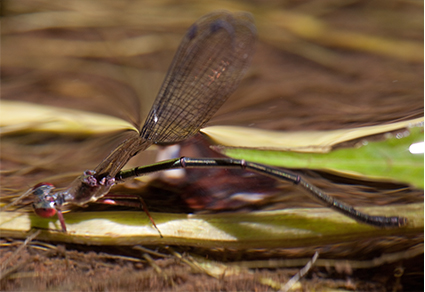Abstract
Nesobasis rito sp. nov. (Holotype ♂, Fiji, Vanua Levu, Drawa, 31 v 2018, A. Rivas-Torres leg.) from the comosa group is here described, illustrated, diagnosed, and compared with morphologically close species of the genus. Nesobasis rito can be distinguished from its related congeners by the shape of the caudal appendages and the ligula. The most similar species are N. comosa and N. heteroneura, which, like N. rito, have the caudal appendages covered by dense setae (especially the first species), but the shape differs clearly in lateral view, with N. rito having longer and more slender appendages, and a basal tooth clearly seen in dorsal view, absent in other members of the comosa group. The specific status of the collected specimens is also supported by the results of genetic analyses, where N. rito appears as a well-supported monophyletic clade. Nesobasis rito also has a distinct distribution from its most similar congeners: it is found on Vanua Levu, while N. comosa is found on Viti Levu and the closely related N. heteroneura is found on Viti Levu and Ovalau. All species of this group are found in streams with native forest riparian vegetation on their respective islands.
References
Beatty, C.D., Van Gossum, H. & Sherratt, T.N. (2007) Nesobasis species diversity and abundance: notes on an endemic genus of the island group of Fiji (Zygoptera: Coenagrionidae). Odonatologica, 36, 13–26.
Beatty, C.D., Sánchez Herrera, M., Skevington, J.H., Rashed, A., Van Gossum, H., Kelso, S. & Sherratt, T.N. (2017) Biogeography and systematics of endemic island damselflies: The Nesobasis and Melanesobasis (Odonata: Zygoptera) of Fiji. Ecology and Evolution, 7, 7117–7129. https://doi.org/10.1002/ece3.3175
Bruzzese, D.J., Schuler, H., Wolfe, T.M., Glover, M.M., Mastroni, J., Doellman, M.M., Tait, C., Yee, W.L., Rull, J., Aluja, M., Hood, G.R., Goughnour, R., Stauffer, C., Nosil, P. & Feder, J.L. (2021) Testing the potential contribution of Wolbachia to speciation when cytoplasmic incompatibility becomes associated with host-related reproductive isolation. Molecular Ecology, 1–16 . [early view] https://doi.org/10.1111/mec.16157
Donnelly, T.W. (1984) Melanesobasis gen. nov., a new genus of Fijian damselflies: a possible link between the platycnemidid Lieftinckia and certain coenagrionids (Zygoptera). Odonatologica, 13, 89–105.
Donnelly, T.W. (1990) The Fijian genus Nesobasis Part 1: Species of Viti Levu, Ovalau, and Kadavu (Odonata: Coenagrionidae). New Zealand Journal of Zoology, 17, 87–117. https://doi.org/10.1080/03014223.1990.10422587
Ferreira, S., Lorenzo-Carballa, M.O., Torres-Cambas, Y., Cordero-Rivera, A., Thompson, D.J. & Watts, P.C. (2014) New EPIC nuclear DNA sequence markers to improve the resolution of phylogeographic studies of coenagrionids and other odonates. International Journal of Odonatology, 17, 135–147.
Futahashi, R. (2011) A revisional study of Japanese dragonflies based on DNA analysis (1). Tombo, 53, 67–74.
Garrison, R.W., von Ellenrieder, N. & Louton, J.A. (2010) Damselfly genera of the New World. Johns Hopkins University Press, Baltimore, Maryland, 490 pp.
Huelsenbeck, J.P. & Ronquist, F. (2001) MRBAYES: Bayesian inference of phylogenetic trees. Bioinformatics, 17, 754–755.
Katoh, K., Misawa, K. & Miyata, T. (2002) MAFFT: a novel method for rapid multiple sequence alignment based on fast Fourier transform. Nucleic Acids Research, 30, 3059–3066.
Kimmins, D.E. (1943) A new species of Odonata from Fiji. Annals and Magazine of Natural History, Series 11, 10, 698–700. https://doi.org/10.1080/00222934308527384
Kumar, S., Strecher, G., Li, M., Knyaz, C. & Tamura, K. (2018) MEGA X: Molecular Evolutionary Genetics Analysis across computing platforms. Molecular Biology and Evolution, 35, 1547–1549.
Lorenzo-Carballa, M.O. & Cordero-Rivera, A. (2009) Thelytokous parthenogenesis in the damselfly Ischnura hastata (Odonata, Coenagrionidae): genetic mechanisms and lack of bacterial infection. Heredity, 103, 377–384.
Lorenzo-Carballa, M.O., Torres-Cambas, Y., Heaton, K., Hurst, G.D.D., Charlat, S., Sherratt, T.N., Van Gossum, H., Cordero-Rivera, A. & Beatty, C.D. (2019) Widespread Wolbachia infection in an insular radiation of damselflies (Odonata, Coenagrionidae). Scientific Reports, 9, 11933. https://doi.org/10.1038/s41598-019-47954-3
Ronquist, F. & Huelsenbeck, J.P. (2003) MrBayes 3: Bayesian phylogenetic inference under mixed models. Bioinformatics, 19, 1572–1574. https://doi.org/10.1093/bioinformatics/btg180
Selys-Longchamps, M.E. (1891) Causeries Entomologiques. No.3. Nesobasis Selys. (Nouveau sous-genre d’Agrionines.). Annales de la Société entomologique de Belgique, 35, 51–58.
Stamatakis, A. (2006) RAxML-VI-HPC: Maximum Likelihood-based Phylogenetic Analyses with Thousands of Taxa and Mixed Models. Bioinformatics, 22, 2688–2690.
Tillyard, R.J. (1924) The dragonflies (order Odonata) of Fiji, with special reference to a collection made by Mr. H. W. Simmonds, F. E. S., on the island of Viti Levu. Transactions of the Entomological Society of London, 1923, 305–346.
Van Gossum, H., Beatty, C.D., Charlat, S., Waqa, H., Markwell, T., Skevington, J.H., Tuiwawa, M. & Sherratt, T.N. (2007) Male rarity and putative sex-role reversal in Fijian damselflies (Odonata). Journal of Tropical Ecology, 23, 591–598. https://doi.org/10.1017/S0266467407004373
Van Gossum, H., Beatty, C.D., Tokot’a, M. & Sherratt, T.N. (2008) The Fijian Nesobasis: A further examination of species diversity and abundance (Zygoptera: Coenagrionidae). Odonatologica, 37, 235–245.
Werren, J.H., Baldo, L. & Clark, M.E. (2008) Wolbachia: Master manipulators of invertebrate biology. Nature Reviews Microbiology, 6, 741–751. https://doi.org/10.1038/nrmicro1969


